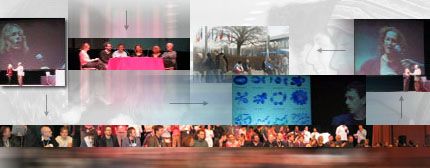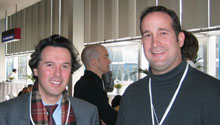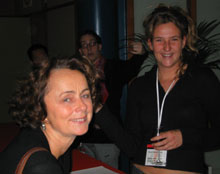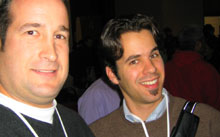NOTE: This is a re-post from 2002. The blog platform, and my content are long gone from the internet - and many of the original links are non-functional. Trying to stitch it back together. So much for digital permanence. Pfft.

To what question is ‘pervasive computing’ the answer?
John Thackera’s generative question at Doors7
Thursday, November 14, 2002
Day 1 of the Doors7 Congress in Amsterdam NL
I am definitely in the right place at the right time. Some great presenters and the theme and content is right on target.
Speakers today included Janine Benyus, author of Biomimicry delivering a fascinating lecture on creating design strategies by learning from similar solutions in nature. Key takeaway: rather than design like machines…design like a living system.
Luis Fernandez Galiano, from Madrid School of Architecture gave a passionate presentation about the pleasures and frustrations of design in a complex world.
David Rokeby and Michael Awad are artists doing some fascinating modeling of patterns in space and time using by using algorithms and filters to modfy video of human movement in public spaces…remember the theme is FLOW.
Lars Erik Holmquist, leader of the Future Applications Lab at the Victoria Institute in Sweden gave an interesting introduction (which I agree 100%” with the key point): “design real stuff, build prototypes, and test it with real people”, which was obviously targeted at designers that deal too much in blue-sky and pray to the gods to deliver the technology too make it work (expressed in his cargo-cult metaphor).
The technology exists today to make some very useful things work IMHO!!!……
Lars is the chair of Ubicomp…and he prefers to use the term “ubiquitous computing”…for obvious reasons. Either/Or IMO, How about ‘Ambient Computing’?
Elena Mavromatti and Achilles Kamesas are doing some fabulous things as part of the Disappearing Computer initiative and leading the project called e-Gadgets as in “Extrovert Gadgets”. Their demonstration was controlling the playback of a wireless MP3 Jukebox with a wireless remote in the form of a light cube…you would change “channels” by rotating the cube different directions.
Marko Ahtisaari (link to his blog) is the Director of Insight and Foresight at Nokia…and is chartered to developing new lines of business at Nokia. He is investigating patterns of existing behaviour that could be extended and enhanced with their technology.
Mindblower of the day was Axel Thallemer…who is the founder of Festo corporate design, who has incorporated biology into industrial design with incredible innovations in Architecture, Transportation, and Consumer products. Although in German text, his book contains illustrations of the many innovations created by Axel and his team.

Friday, November 15, 2002
Day 2 of the Doors7 Congress in Amsterdam NL
Another day of incredible presentations. My head is full.
Bruce Sterling kicked things off with expected Sterling-esque dystopian future scenario based on the wonders of ubicomp, or pervasive computing…an example of “battlefield intelligence” and subsequent detachment by military forces…eSoldiers. Was a great start, and got the crowd loosened up…but on edge. This shit COULD be dangerous, and designers have a responsibility to make things usable…which tied into a key theme of the dicussion this week.
One other theme was “dashboards” (and one of my main reasons for attending) which fell completely flat in the show, but outlined very insightfully by John Thackera in his article “Real-time design in the ‘world as spreadsheet'”. He was asking great questions on the panels…looking for the big picture, to look for the interconnections between science/biology, Technology, Architecture, Design, and Human Facors (another theme). The panel on “dashboards” /was/ entertaining…but completely missed the opportunity that these dashboards do imply a positive control (as opposed to “control:power”). It is the type of control than can help comanies reduce wasteful inventories, reduce the number of empty trucks driving around…and can also more intelligently use raw materials…for example. On looking for the big picture issue…I see where he is going, but often the guest responses are decidedly intra-disciplinary (?). Everyone /says/ that there needs to be a crossing of disciplines to create new solutions…but few are really doing it, (with the exception of Axel Thallemer and a few others to add) falling back on established disciplinary descriptions of applications. Which is understandable.
Fortunately some guys from Moto(rola) are thinking up completely NEW things. Marco Susani, a strategic designer at Motoroloa is defining types of flow and creating a new ontology to describle the flow in complex networks. The old terms somtimes do not work, and this seems to be a great excecise for defining the scope of a systems design…if one can characterize and name TYPES of flow. Thats new. The presenation was passionate and very emotional/beautiful in the descriptive graphics. If anything was missed (maybe I missed it), it would be that fact that for any individual there exists many diverse and overlapping types of flow (stratification). All of the models are interwined…PLUS the fact that there are multiple connections BETWEEN the models creating a scale-free network.
Felice Frankel delivered a great presentaion based on her book Envisioning Science (link), which she also signed a copy for me, thank you. Just buy the book. No embellishment needed.
THEN came the real mindblowers. Philip Tabor, architect, delivered a beautiful concept called a ‘simulation space for half formed thoughts’…a ‘daydream engine’. He was looking for vagueness an fuzzy edges vs. sharp contrast in the design of Spaces, Systems, and I guess a NEW way to think about a new “epistemology of the creative process” (i just made that up).
Patricia de Martelaere, philosopher, was everything you would hope for. Being and becoming. Platos ideal static world (shadows). The non-existence of “real time”. Which also means there may need to be a new term…because “real” and “time” have too much baggage. Perhaps any improvement in usefulness, utility, benefit, value that is created can be considered as a move toward “real time” even though, philosophically (and possibly scientifically) that something called “real time” does not exist.
OK. Move on.
Joshua Davis. Awesome. Just like every other rad developer dude I have ever known….has done some incredible Flash scripting. He has been able to COMMUNICATE through his book Flash to the Core . Had the crowd rolling. Incedble work, with attitude (worth another paragraph).
The OPEN DOORS contest, well lets just say there were only 3-4 contestants that were really in the ballpark….the ones with incredible concepting and execution vs. the ones that were average stuff with the word “pervasive” or “flow” slapped on them as an afterthought. (more later on how Ben Hooker and Shona Kitchen from Royal College of Art UK was, IMO, the best of the show the with their Altavistas Project).
Some Pics!
 "Doors divas" Ine and Dagmar. The entire staff was fabulous! Congrats!
"Doors divas" Ine and Dagmar. The entire staff was fabulous! Congrats!
 Koen Koevoets of Koen&Co in Utrecht was especially gracious and a really nice guy to have a few Heinekens with.
Koen Koevoets of Koen&Co in Utrecht was especially gracious and a really nice guy to have a few Heinekens with.
 The American phenom of "Speed-dating" worked in the new Flow context as a way to meet a lot of people fast!
The American phenom of "Speed-dating" worked in the new Flow context as a way to meet a lot of people fast!
Saturday, November 16, 2002
Day 3 of the Doors7 Congress in Amsterdam NL.
The show ended on a high note and seemed to be a great success. I agree. The ideas and interconnections…the flow created by the conference itself was quite amazing. The flow of ideas, concepts, prototypes, and processes came together across Biology, Theoretical Physics, Art, Music, Software Development, Critical Theory, and Device Development…as well as proposing the physical topology and conceptual models to deal with the design of interconnected/networked systems.
What a great chance to meet people who are thinking really hard about these issues and kudos to the Doors team for the foresight to assemble these different disciplines that must create together to design and deliver systems that are highly usable, convenient, sustainable, value creating (in many ways), along with the new responsibility for design decisions in this context.
Control came up as a theme both good and bad…and may be worthy of a new conference. Control:Convenience. It means different things to different people and within different contexts.
J.C. Herz, of JoystickNation has revealed that the character and nature of MMORPGs, and even The Sims represents a new development model that includes the users to enhance modify and maintain the software. (Much more on that later!!!)
Franziska Nori of DigitalCraft delivered a passionate plea to reinvent the museum space. What is it for now? Is it relevant? Should it contain everything, or be an arbiter? Who are the customers, the users, the producers? What is the motivation to be represented in a museum? And, one of the biggest questions was “who is the public, and what public do museums cater to?“
Ezio Manzni, professor of industrial design at Milan Polytechnic. The Sustainability guy. The depiction of networked systems as either “large and fast” (the Highway…Airport, Distribution Networks) and also in a tighter mesh that is “close and slow” (the neighborhood, people-processes).
I think this reflects a philosophical approach to the scale-free networks described in Linked: The New Science of Networks by Albert-László Barabási (2002) and Nexus: Small Worlds and the Groundbreaking Theory of Networks by Mark Buchanan (2002).
Natalie Jeremijenko showed project with Robotic feral dogs to detect radioactivity, etc. (using modified aibos etc) and some profound thoughts. (More later…)
Neil Gershenfeld, director of Center for Bits and Atoms at MIT wants to take technology DEVELOPMENT to people that need it…whether it is eskimos to help manage wildlife populations (or to help designers that need help perhaps). This was not GIVING them technology that someone else invented but helping rural communites develop systems that THEY think would benefit. The opinion in the crowd was that this was a double edged sword.
